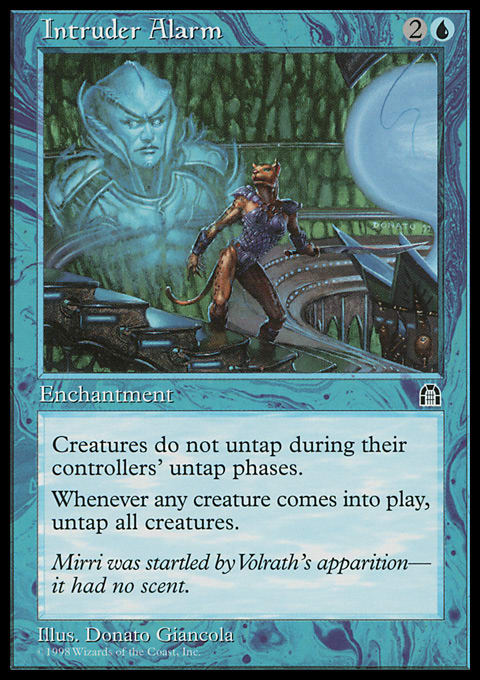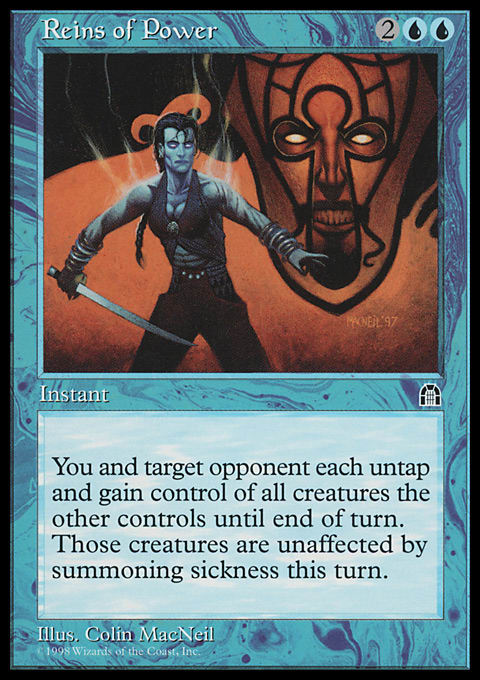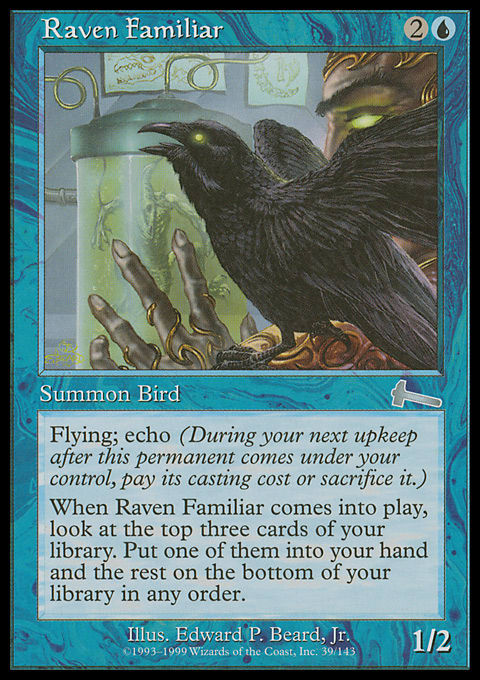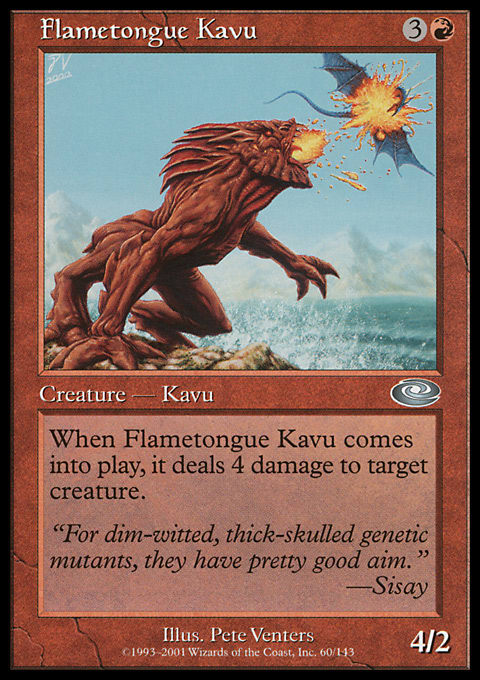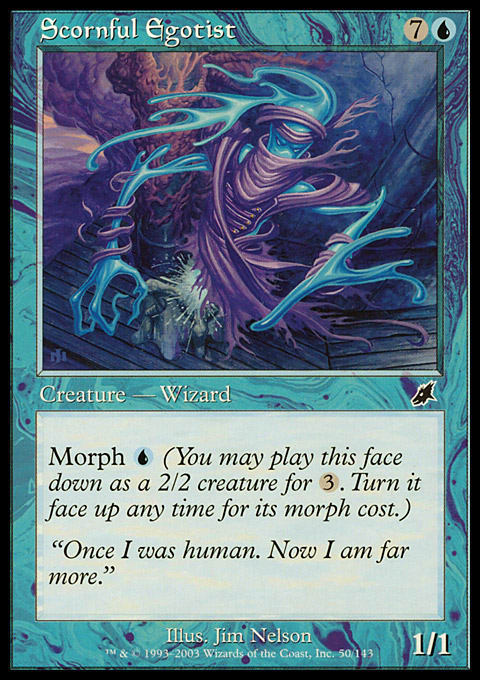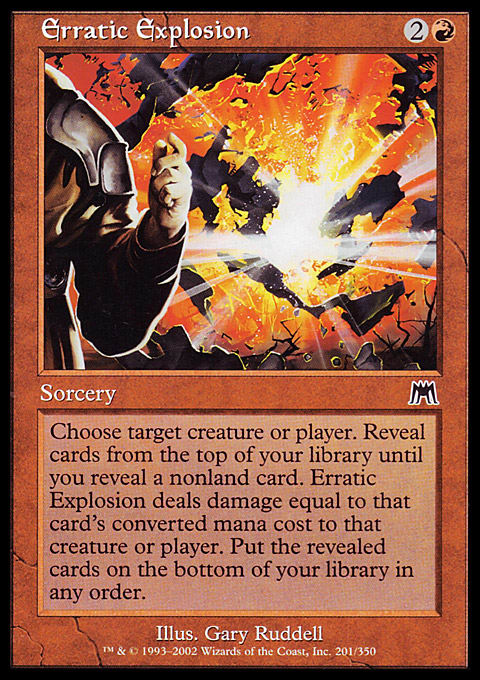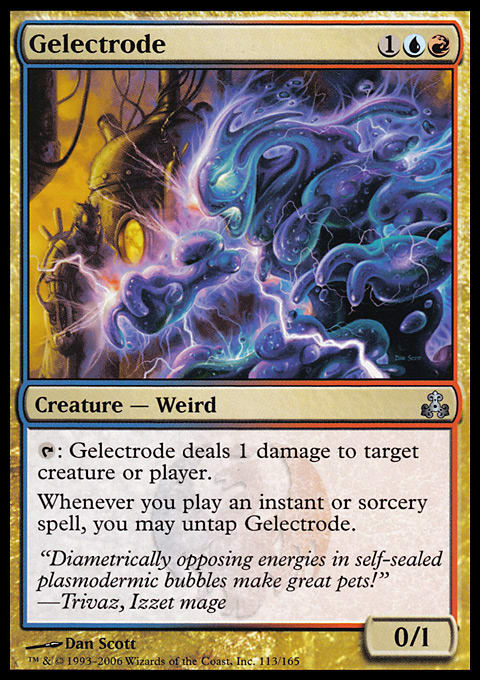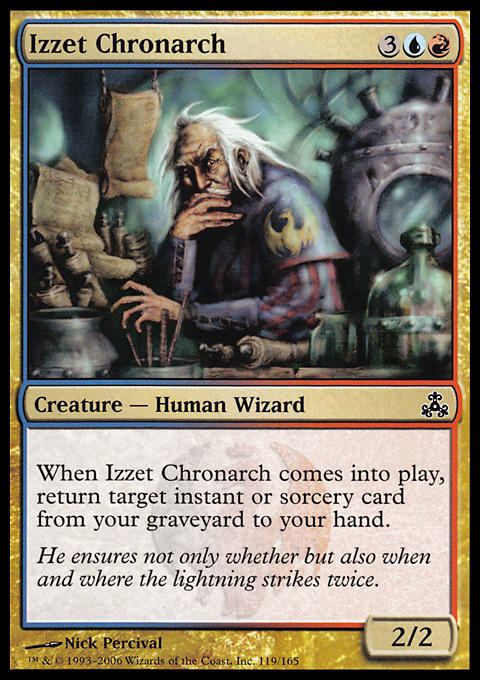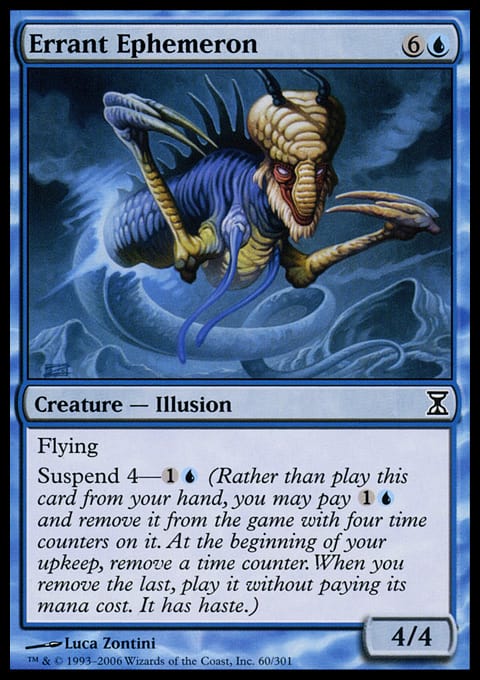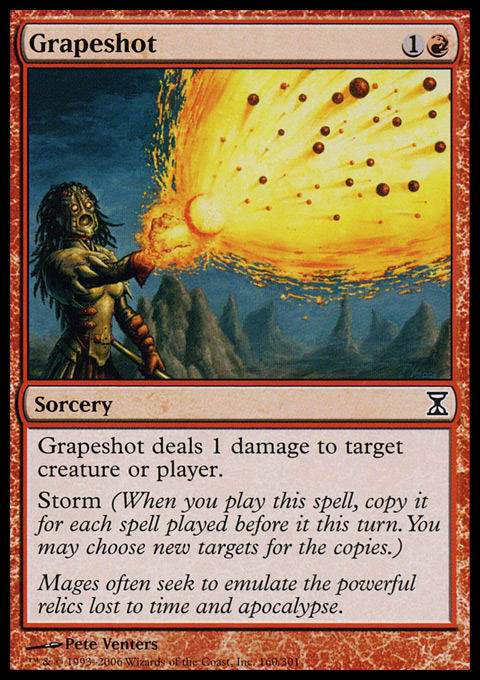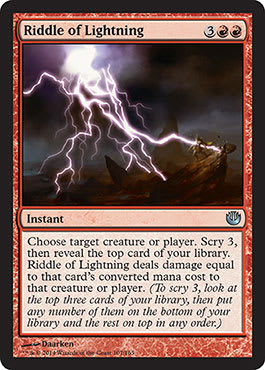Madcap machinists. Crazed scientists. Nutty professors. Thanks to the Izzet guild created for the original Ravnica block, the color tandem of Red and Blue will always conjure up a certain image in our minds. But if we look at the history of U/R Theme Decks, the predecessor of the Intro Pack (and Planeswalker Deck) that spanned from 1997’s Tempest to 2008’s Eventide, we find a tremendous spectrum of focus and identity.
Today we’re going to look at the history of the U/R archetype, as it was expressed though Theme Decks across Magic’s history. The Izzet paradigm bookended the history of the product, from the very first block to the last. What were the differences? How did they illustrate the particular joy of Magic that comes from pairing two of the most spell-hungry colors in the game? Let’s hop in the time machine and take a stroll through the history of the game. Spin those dials, it’ll be a wild one!
Year: 1998
Deck: The Sparkler
Set: Stronghold
Rares: Evacuation, Intruder Alarm, Reins of Power
With Theme Decks introduced only the set before in Tempest, Wizards was effectively starting with a clean slate. What would they do to showcase the pairing of Red and Blue? Why, simply create one of the greatest Theme Decks of all time, that’s what! You don’t have to just take my word for it, either — Abe Sargent rated this deck the best Theme Deck of all time (and his personal favorite precon) back in 2011.
The Sparkler was an unusual deck, renowned for a feat that has never been repeated: it only had three creatures. That’s right, three: a Mogg Fanatic, a Wall of Razors, and a Wall of Tears. Now, even in the more creature-friendly era of modern Magic we see control decks with only a few, but those invariably serve the role of closers. Nobody in 1998 was closing with a Wall of Razors.
So how did the deck play out? Take it away, Abe!
You are playing a deck with three creatures, no mass removal, and only nine burn spells, if you are generous and count Mogg Fanatic as a burn ”spell.” How do you win?
You win through tempo and patience. You win by finding and protecting Propaganda, walls, and more. You Evacuation to give yourself several turns without having to worry about creatures attacking you. You win by using Mind Games and Intruder Alarm to lock down your opponent’s creatures. You win by buying back Capsize over and over again to bounce any threats. You win by playing Reins of Power, attacking with everything they have, which will tap your opponent’s creatures and lock them down under an Intruder Alarm. You win by countering anything that will cause you to lose. Quite frankly, you win by being desperate, the whole time. Every game is a struggle, and every time you play, it feels like you are drowning behind creatures and life loss, until you manage to stabilize at 3 life and win the game.
Year: 1999
Deck: Battle Surge
Set: Urza’s Destiny
Rares: Goblin Marshal, Urza's Incubator
The very next block saw Battle Surge as part of Urza’s Destiny’s lineup of Theme Decks. Whereas The Sparkler harnessed the power of spells, Battle Surge — as the name indicated — was a lot more grounded in the red zone. This one packed in a very dense twenty-three creatures, along two strategic lines. The majority of creatures were ones like Viashino Sandscout, Keldon Champion, or Thundering Giant, all of which can hit the turn they enter play thanks to haste. The second avenue were evasive Blue creatures like Thieving Magpie and Raven Familiar that generated card advantage. And if you got spoiled by the haste creatures in Red, the deck thoughtfully even included a copy of Mark of Fury for those birds.
Tactically, the deck was all about disruption your opponent through plays like Curfew and Fatigue, then cranking out the burn and hasty beaters to pull ahead and never look back. It wasn’t a perfect strategy, but it did provide an interesting contrast in playstyle from The Sparkler, and further highlighted the range of possibilities afforded by playing these two colors.
Year: 2001
Deck: Whirlpool
Set: Apocalypse
Rares: Suffocating Blast, Whirlpool Warrior
After a bit of a drought, having been left out of any Theme Deck from Mercadian Masques Block, we are treated to one at the tail end of Invasion Block with Apocalypse’s Whirlpool.The deck has a few things in common with the previous one, in that it strings together a large mass of creatures with a combat-relevant ability, uses its spell complement to harass and disrupt, and looks to obtain card advantage over the opponent.
In this case, however, rather than going through the red zone like a linebacker, Whirlpool opts to go above it, with a third of its creatures possessing flying. It’s also quite happy to use its creatures as sources of direct damage, as seen with cards like Minotaur Illusionist, Flametongue Kavu, Razorfin Hunter, and Quicksilver Dagger.
The card advantage element, however, is what makes the deck truly stand out. For one thing, the deck packs a lot of cantrips like Opt, Confound, and Exclude. But it’s the “whirlpool” mechanic found on Whirlpool Warrior, Whirlpool Rider, and Whirlpool Drake that distinguishes it. This lets you flush away a hand of junk you don’t need in hopes of drawing into things you do. Combined with the virtual card advantage of two-for-one cards like the aforementioned Flametongue Kavu and Jilt, and this was a deck that won off of incremental advantage.
Year: 2002
Deck: Air Razers
Set: Judgment
Rares: Scalpelexis, Worldgorger Dragon
Ahh, Odyssey Block. This was a period of time when Theme Decks were graced with some of the worst names imaginable, like “Trounce-O-Matic” and “Spectral Slam.” Our Izzet deck of ’02 doesn’t fare much better in the naming department, but however cheesy and dated the titles are, the foundations of the deck are something the modern-era Magic player will recognize immediately. Simply put, Air Razers is a Skies deck with a burn suite to keep the blocking at bay.
Sure, we saw a bit of that in the last deck, Whirlpool, but Air Razers ups the size of the air force, from smaller creatures like the Skywing Aven and Aven Fisher right up to the top of the mana curve with the Worldgorger Dragon, a very potent card that has seen play in Legacy thanks to its pivotal role in an infinite loop combo (with Animate Dead). While it offers no such shenanigans here, the deck does have a few other tricks up its sleeve.
Indeed, you can be forgiven for picking up a faint Innistrad vibe here when looking over the rest of the deck, given that two of the mechanics it features have been reused there. First, you’ve got madness cards like Fiery Temper and Violent Eruption, and a very solid discard enabler with Compulsion to go with it. Second, while the threshold mechanic featured here never made it back to Innistrad, it was the inspiration for Shadows over Innistrad’s delirium. Here, getting seven or more cards in your graveyard isn’t especially difficult when you’ve got lots of burn to splash and ways to discard for madness, and then cards like Chainflinger and Shower of Coals get just that much better.
Year: 2003
Deck: Pulverize
Set: Scourge
Rares: Mischievous Quanar, Parallel Thoughts
Just when it looked like we were settling in to some fundamental Magic, along comes Pulverize to throw us the wildest curve we’ve seen since The Sparkler. When head designer Mark Rosewater talks about cards that confused people when taken out of the context of their environment, the one card that always comes up is Scornful Egotist, which is right up there alongside One with Nothing in the “Why Would Anyone Ever Play That?” category.
But this is Magic, and there’s always an answer. Welcome to Scornful Egotist’s home turf. Pulverize is a “converted mana cost matters” deck, packed with creatures so expensive that a bit of nausea is forgivable, even expected. Not just three copies of the Scornful Egotist, but things like the Skittish Valesk and Macetail Hystrodon. Forget “Pulverize,” in the Era of Goofy Names it’s a tragedy that “Sticker Shock” wasn’t the one they settled on.
And the payoff for all this pain? Frankly, a bit suspect. Sure you could live the dream of an eight-point Erratic Explosion, a card that tellingly was brought back in Rise of the Eldrazi (another “expensive creatures” set) as Explosive Revelation. But the lion’s share of “cost matters” cards actually required you to play your overpriced army, as with Dispersal Shield, Rush of Knowledge, or Torrent of Fire. Ouch.
On a final note, the blurb on the mothership is well worth a look, as even it has to sip the “Magical Christmasland” cider to get this to seem like a good idea.
Year: 2006
Deck: Izzet Gizmometry
Set: Guildpact
Rares: Leyline of Lightning, Tibor and Lumia
Although it featured enough in the Theme Decks of Mirrodin Block, Blue all but went into hiding in the subsequent Kamigawa Block, with only two decks out of twelve running the color (although in fairness, one of them was the superb Ninjutsu deck for Betrayers). Consequently, we see a long break for the U/R combination, but the waiting paid off as Ravnica arrived and with it, a proper name for the pairing.
Ravnica did such a great job branding the then color pairs that they’re an indelible part of Magic’s modern lexicon. Not only will modern-era players instantly place the name “Izzet,” but they’ll also be able to place the theme of Izzet Gizmometry. Since Stronghold, we’ve seen archetypes both common (Skies, tempo) and obscure (CMC matters), but for the first time we see the “spells matter” strategy that’s now a hallmark of the pairing.
And oh boy did Izzet Gizmometry want you to be casting! The build somewhat evokes The Sparkler in that it’s light on creatures and heavy on spells, but unlike the Stronghold deck, the fact that you’re casting spells has some mechanical relevance. Cards like Gelectrode, Tibor and Lumia, and Wee Dragonauts gave you bonus effects every time you cast a spell. The Izzet Guildmage let you copy them, while the Izzet Chronarch fetched them back from graveyard to hand.
And the spells, oh the spells! From burn (Electrolyze, Pyromatics) to bounce (Repeal, Vacuumelt), from card draw (Train of Thought, Telling Time) to countermagic (Frazzle, Convolute), this deck did it all. Fittingly for the Izzet, there were loads of ways the deck could go wrong, particularly given the reliance on a small number of creatures to do most of the work, but when it went right . . . ?
BOOM.
Year: 2006
Deck: Reality Fracture
Set: Time Spiral
Rares: Deep-Sea Kraken, Pardic Dragon
What a year for the Izzet. Not only did they get the spell-heavy Izzet Gizmometry, but they also got one of the most intricate, fun-to-play and unusual Theme Decks Wizards ever printed in Reality Fracture. This one falls right in line with The Sparkler and Pulverize in that its central strategy varies quite a bit from the norm.
Time Spiral was a type of set that Wizards is unlikely ever to do again, pulling in homages and references and mechanics from all throughout the set’s history. It wasn’t that the set failed; it was, in fact, a hit with longstanding, enfranchised players. But for the new players, who had to grapple with something like forty-four different mechanics in a single set, it was perhaps a bit much to ask.
One of the things Time Spiral did was explore the interplay between different set mechanics that were never in play at the same time. Reality Fracture did precisely that, pairing up the new suspend mechanic, which let you cast things cheaply if you were willing to wait a few turns to see it bear fruit, and Scourge’s storm. Since once the suspend effect had worn off, the suspended spell would cast and resolve as normal, which would help fuel larger storm effects.
The deck had no shortage of things to suspend, packing cards like Errant Ephemeron, Keldon Halberdier, and Rift Bolt. Manage to line up enough things coming off of suspend in a single turn, and you could end up with a truly massive Empty the Warrens, Grapeshot, or Ignite Memories for your opponent to content with, thanks to storm.
Now, getting the timing lined up perfectly for a fat storm surge is a bit tricky. After all, different suspend cards are on different timers, and this being Magic you never know what you’re going to draw. Luckily, the deck gives you a few tools to play around with time and get things lined up just right. Jhoira's Timebug and Clockspinning both let you either add or remove counters, so you can synchronize your suspended spells to all pop on the same turn.
The deck takes a lot of micromanagement to get everything firing off when it needs to. It’s not for everybody, but if that sort of mental puzzle is your cup of tea, you’ll find Reality Fracture to be one of the best Preconstructed Magic experiences ever made.
I certainly have!
Year: 2007
Deck: Fate Blaster
Set: Future Sight
Rares: Magus of the Future, Shapeshifter's Marrow
As we approach the end of the era of the Theme Deck, we’ve got just a couple more entries in the U/R family. As we’ve seen, broadly speaking there are two different kinds of Theme Decks covered today. The first kind you might call, “look what Red and Blue can do!” This showcases different or unusual strategies enabled by the pairing of the two colors. Decks like The Sparkler, Pulverize, and Reality Fracture fall here.
The other approach is, “look at how Red and Blue can do this!” This approach takes the more ‘ordinary’ aspects of the game (like attacking with creatures and having spell support) and puts an Izzet twist on it. Here we find things like Battle Surge and Air Razers, which simply attack with creatures in a particularly U/R flavor, without having to jump through a lot of hoops.
Fate Blaster would like you to believe it falls into the former camp, as the Wizards of the Coast blurb plays up the scry aspects of the deck. “The “Fate Blaster” deck is designed to let you get ahead of yourself,” it declares. “That’s because you’ll have your head in the future, molding fate to your whims. This deck is packed with scry effects, from Mystic Speculation to Riddle of Lightning to Cryptic Annelid. Keep manipulating the top of your deck, and you’ll keep drawing the cards you need.”
Yes and no. While yes, it’s true that scry has some presence in the deck, the deck doesn’t do anything with it. To break from the norm, you’d need to see something that specifically rewarded you for scrying, much like Astral Slide does for cycling. This is much more of a “good stuff” sort of deck, one that has a large number of conventional creatures and lines of play, and less of a combo or mechanically-themed entry.
Even the “good stuff” isn’t that great. Sure it’s fun to get the chance to play Dandan or Uthden Troll again, for those who remember playing these the first time, but by and large it’s just a collection of non-synergistic beaters, from Blind Phantasm to Boldwyr Intimidator. Not the most exciting entry on the list, but then Reality Fracture in the same block is also a hard act to follow.
Year: 2008
Deck: Sidestep
Set: Eventide
Rares: Dominus of Fealty, Mindwrack Liege
One block later, we’d see the Theme Decks retired forever, replaced by the Intro Packs — at least, until those in turn were replaced with Planeswalker Decks in Kaladesh. Sidestep didn’t bring anything new to the table thematically, but instead focused on creatures and effects that highlighted the unpredictable and tricky nature of the Izzet color pairing.
Here, nothing was quite as it seemed. Cards like Merrow Levitator, Riverfall Mimic, and Crag Puca helped keep your opponent off-guard, unsure of what they might actually be facing in the red zone. The Dominus of Fealty ensured that even their own forces might turn against them, and Inside Out could flip reality at a moment’s notice. There was some iron underneath the velvet, thanks to cards like Shrewd Hatchling, which the deck carried three copies of, and Outrage Shaman, the set’s version of the previously-highlighted Flametongue Kavu. This may have hewed close to convention without a specific theme to rally around, but even then in the grand Izzet tradition it kept your opponent guessing what you might do next.
Overall, it was a fascinating run for the Izzet colors during the life cycle of the Theme Deck, including one of the best Theme Decks to have been produced. Next week, we’ll move into the Intro Pack age — an age of very different compositions and criteria — and see how Red and Blue fared.
Have you played any of these decks? Have a particular favorite or story to share? We’d love to hear it in the comments below!













